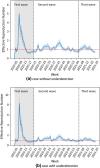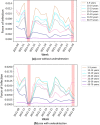Age-specific contribution of contacts to transmission of SARS-CoV-2 in Germany
- PMID: 36593336
- PMCID: PMC9807433
- DOI: 10.1007/s10654-022-00938-6
Age-specific contribution of contacts to transmission of SARS-CoV-2 in Germany
Abstract
Current estimates of pandemic SARS-CoV-2 spread in Germany using infectious disease models often do not use age-specific infection parameters and are not always based on age-specific contact matrices of the population. They also do usually not include setting- or pandemic phase-based information from epidemiological studies of reported cases and do not account for age-specific underdetection of reported cases. Here, we report likely pandemic spread using an age-structured model to understand the age- and setting-specific contribution of contacts to transmission during different phases of the COVID-19 pandemic in Germany. We developed a deterministic SEIRS model using a pre-pandemic contact matrix. The model was optimized to fit age-specific SARS-CoV-2 incidences reported by the German National Public Health Institute (Robert Koch Institute), includes information on setting-specific reported cases in schools and integrates age- and pandemic period-specific parameters for underdetection of reported cases deduced from a large population-based seroprevalence studies. Taking age-specific underreporting into account, younger adults and teenagers were identified in the modeling study as relevant contributors to infections during the first three pandemic waves in Germany. For the fifth wave, the Delta to Omicron transition, only age-specific parametrization reproduces the observed relative and absolute increase in pediatric hospitalizations in Germany. Taking into account age-specific underdetection did not change considerably how much contacts in schools contributed to the total burden of infection in the population (up to 12% with open schools under hygiene measures in the third wave). Accounting for the pandemic phase and age-specific underreporting is important to correctly identify those groups of the population in which quarantine, testing, vaccination, and contact-reduction measures are likely to be most effective and efficient. Age-specific parametrization is also highly relevant to generate informative age-specific output for decision makers and resource planers.
Keywords: Age-specific viral spread; COVID-19; Compartment models; Epidemiological modeling; Infection severity; SARS-CoV-2; Underdetection.
© 2023. The Author(s).
Figures















References
MeSH terms
Grants and funding
LinkOut - more resources
Full Text Sources
Medical
Miscellaneous

